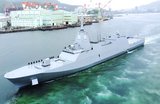BAE shipbuilding steps into the future
BAE Systems has constructed a network of ‘visualisation suites’ at its sites in Glasgow, Portsmouth and Bristol, as it overhauls its approach to the design and build of Royal Navy warships by using virtual reality technology.
The visualisation suites create a full scale 3D ship prototype, enabling engineering teams to virtually build and test the design of vessels in advance of the first steel being cut.
A laser tracking system and interactive wand allows operators to fly through a ship’s design from any angle, giving them the ability to inspect and examine specific areas, equipment and systems, quickly and easily. This allows engineers to identify and address potential issues in real time; while also enabling greater collaboration and engagement with suppliers and customers, bringing them into the design process at an earlier stage.
The suites, which have been in use under a pilot programme since February, have played a role in the design of the Royal Navy’s new Offshore Patrol Vessels, with teams also using the tool to further mature the design of the Type 26 Global Combat Ship.
Mick Ord, managing director, BAE Systems Naval Ships, said: ‘Visualisation technology is transforming the way we design, build and deliver complex warships. By creating a virtual prototype, we can mature and optimise a ship’s design and gain a real understanding of the vessel and the experience of those serving on board before manufacturing begins.
‘This new tool forms part of our wider investment activity as we create a world class UK naval engineering business. New facilities, processes and ways of working will enable a step change in efficiency, quality and safety, helping to ensure we remain competitive and deliver the best value for money to our customers.’
The virtual reality technology is supplied by SME Virtalis.
More from Digital Battlespace
-
![Babcock nears first customer for Nomad AI translation tool]()
Babcock nears first customer for Nomad AI translation tool
Nomad can provide militaries with real-time intelligence, saving critical time on the battlefield.
-
![AUSA 2025: Israel’s Asio Technologies to supply hundreds of improved Taurus tactical systems]()
AUSA 2025: Israel’s Asio Technologies to supply hundreds of improved Taurus tactical systems
Taurus operates alongside the Israel Defense Forces’ Orion system which supports mission management across tens of thousands of manoeuvring forces, from squad leaders to battalion commanders.
-
![AUSA 2025: Kopin pushes micro-LED plans as China moves faster]()
AUSA 2025: Kopin pushes micro-LED plans as China moves faster
The plan for the new displays follows fresh investment in Kopin’s European facilities by Theon and an order for head-up displays in fielded aircraft, with funding from the US Department of Defense.
-
![AUSA 2025: Persistent Systems to complete its largest order by year’s end]()
AUSA 2025: Persistent Systems to complete its largest order by year’s end
Persistent Systems received its largest ever single order for its MPU5 devices and other systems earlier this month and has already delivered the 50 units to the US Army’s 4th Infantry Division.
-
![Aselsan brings in dozens of companies and systems under the Steel Dome umbrella]()
Aselsan brings in dozens of companies and systems under the Steel Dome umbrella
Turkey has joined the family of countries attempting to establish a multilayered air defence system with government approval in August 2024 for the effort landed by Aselsan. Dubbed Steel Dome, the programme joins Israel’s Iron Dome, the US Golden Dome, India’s Mission Sudarshan Chakra and South Korea’s low-altitude missile defence system.
-
![DSEI 2025: MARSS unveils new agnostic multidomain C4 system]()
DSEI 2025: MARSS unveils new agnostic multidomain C4 system
MARSS’ NiDAR system has been deployed using sensors from static platforms to provide detection and protection for static sights, such as critical infrastructure, ports and military bases.




























